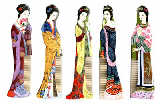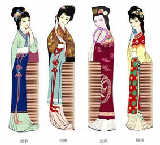Changzhou Shubi in history
 |
 |
 |
Changzhou is Shubi's hometown. In Sui Dynasty (581-618 AD), the Jinghang Grand Canalcrossed through Changzhou city. At that time, all streets and alleys on both banks of the canal were jammed with comb workshops, and won titles of Mushu Street (Wooden Comb Street) and Biji Alley (Fine-toothed Comb Alley).
Standing on Wenheng Bridge with a right moon above and the Flower Street and Biji Alley below, one might enjoy the reflection of moonlight and lamps in the waves, and hear an ensemble of water, voices, steps , sculls and bamboo being split. The ancients named it the "Wenheng across the moon and comb shops lighting," and listed it as the first one of eight sights in the west suburbs of Changzhou.
In the region of Qianlong Emperor (1711-1799) during theQing Dynasty, almost every family in Changzhou made Shubi. In the Guangxu age, in July of every lunar calendar year,SuzhouWeaving Office would order 60 pieces of Changzhou boxwood combs and 60 pieces of first-class, fine-toothed combs with plum backs and eburnean teeth. Then, in October, together with sixdragonrobes and 600 royal flowers, they would be sent to theForbidden Cityand presented to the emperor. This was the origin of royal combs. It was said that Queen Mother Cixi especially cherished combs from Changzhou.
After the Republican Revolution of 1911, the demand for fined-toothed combs rapidly increased as more and more people began to cut their braids. At that time, a kind of small fined-toothed comb named " Liuhai Shubi" was very popular. Many people hung it from their pocket, and it became a fashion style.
Later, the Changzhou comb and fined-toothed comb were gradually introduced to the world. In 1915 they won the silver award in Panama International Exposition, and in 1926 won the gold award at the Philadelphia International Exposition in the United States.










